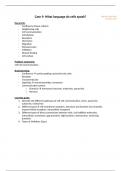Case 9: What language do cells speak? BBS1001 2023/2024
3 oktober 2023
Keywords:
- Confluency (tissue culture)
- Neighboring cells
- Cell communication
- Cell division
- Receptors
- Hormones
- Migration
- Pertussis toxin
- Inhibition
- Wound healing
- Cell surface
Problem statement:
Cell-cell communication
Brainstorming:
- Confluency surface getting covered by the cells.
- Receptor
- Transmembrane
- Signaling neurotransmitter, hormones
- Communication system
o Chemical hormones (exocrine, endocrine, paracrine)
o Nervous
Learning goals:
1. Describe the different pathways of cell-cell communication. (ionic, paracrine,
autocrine, endocrine)
2. Different types of cell membrane receptors. Structure and function (ion-channels,
enzyme linked receptors, intracellular receptors)
3. Different types of direct connections between cells. (cell addition molecules,
intercellular connection, gap-junctions, tight junction, desmosome, anchoring
junction)
4. Types of inhibitors (Gprc)
, Case 9: What language do cells speak?
1. Describe the different pathways of cell-cell communication. (ionic, nervous, paracrine,
autocrine, endocrine)
Ionic channel signaling
?
Endocrine signaling
Signals from distant cells are called endocrine signals, and they originate from endocrine
cells. (in the body, many endocrine cells are located in endocrine glands, such as the thyroid
gland, the hypothalamus, and the pituitary gland) these types of signals usually produce a
slower response but have a longer-lasting effect. The ligands released in endocrine signaling
are called hormones, signaling molecules that are produced in one part of the body but
affect other body regions some distance away.
Hormones travel the large distances between endocrine cells and their target cell via the
bloodstream, which is a relatively slow way to move throughout the body. Because of their
form of transport, hormones get diluted and are present in low concentrations when they
act on their target cells. This is different from paracrine signaling, in which local
concentration of ligands can be very high.
Autocrine signaling
Autocrine signaling are produced by signaling cells
that can also bind to the ligand that is released. This
means the signaling cell and the target cell can be the
same or a similar cell. This type of signaling often
occurs during the early development of an organism
to ensure that cells develop into the correct tissue
and take on the proper function. Autocrine signaling
also regulates pain sensation and inflammatory
responses. Further, if a cell is infected with a virus, the
cell can signal itself to undergo programmed cell
death, killing the virus in the process. In some cases,
neighbouring cells of the same type are also
influenced by the released ligand. In embryological
development, this process of stimulating a group of
neighbouring cells may help to direct the
differentiation of identical cells into the same cell
type, thus ensuring the proper developmental outcome.
Paracrine signaling
Signals that act locally between cells that are close together are called paracrine signals.
Paracrine signals move by diffusion through the extracellular matrix. These types of signals
usually elicit quick responses that last only a short amount of time. In order to keep the
response localized, paracrine ligand molecules are normally quickly degraded by enzymes or
removed by neighbouring cells. Removing the signals will re-establish the concentration




